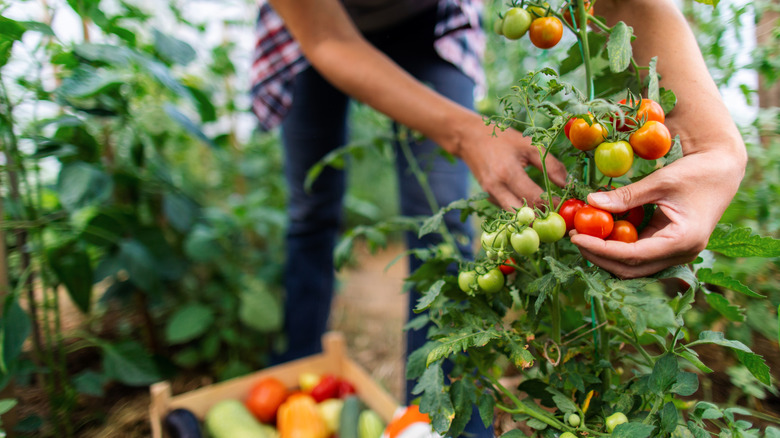Why Your Tomato Plants Have Bottom Rot And How To Prevent It
Countless gardeners know the joy of watching well-tended tomatoes evolve on the vine — and the horror of discovering a brown, leathery spot on the bottom of those precious beefsteak, roma, or heirloom beauties. Though thoroughly disappointing, it's good to know that this isn't a disease or insect-driven malady, nor is it caused by harsh weather. It's a condition called blossom end rot (BER), informally known as bottom rot, and it's pretty easy to prevent once you know how.
The cause of bottom rot on any type of tomato is a lack of calcium, which enters tomato plants through moisture. In other words, the soil in which the plants grow needs the right amount of water. Even if the soil itself has plenty of calcium, tomatoes need an even, consistent supply of water to actually move it into the fruit. A sudden dry spell or heavy rain can complicate calcium transport, and before you know it, the tissue at the end of that prized red tomato begins to rot and die, resulting in a brown patch that increases in size, darkens in color, and can develop a secondary layer of black mold.
Another cause of BER can be damaged plant roots, sometimes brought on by incorrect or harsh root pruning. The compromised tomato roots can prevent water absorption — and, again, calcium doesn't make its way to the tomato. Other potential contributors to rot can be over-fertilizing or using soil that's too acidic.
How to prevent bottom rot when growing tomatoes
Luckily, there are plenty of ways to prevent bottom rot from occurring. The one thing that's easiest to control is watering your tomato plants. Rather than an erratic approach, make a schedule that facilitates about 2 inches of water per week in hot summer months, ideally no more and no less, which provides a consistent flow of calcium from roots to fruits. It helps to add a layer of mulch, such as straw or compost, to lock in the moisture.
Skip heavy nitrogen fertilizer feeds — the last thing your tomatoes need is an additive that diverts calcium away from the juicy fruits. Consider testing your soil for acidity a few months before the planting season; if it's extra acidic, at or below a pH of 5.5, add some gardening lime, also known as dolomitic lime.
If one or more tomatoes do end up with blossom end rot, just pull them off the vine and compost them. As you remedy the situation and put proper gardening practices in place, this opens up room for the plant to produce a whole new crop of healthy, tasty 'maters for your cooking and dining. A final word about solutions such as foliar calcium sprays; experts tend to agree that these sprays are temporary solutions and unlikely to genuinely solve the problem. When it's time to eat those perfect tomatoes, check out our article on 20 ways to make tomatoes even more delicious.

